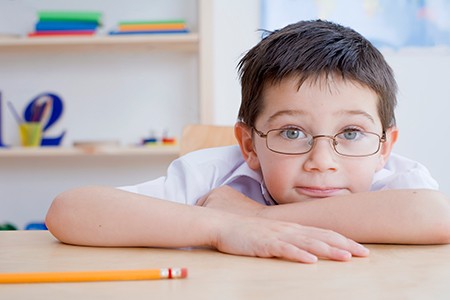From birth, your child should receive a pediatric eye exam regularly from a medical professional to identify any eye problems that may lead to visual impairment.

“It is important to have your child’s eyes looked at before the age of one, and then followed up with examinations between age 3-5, before first grade, and then annually after that,” said Dr. Jill Dillon, a Marshfield Clinic Health System optometrist. “Children’s vision can change quite rapidly, especially during growth spurts, so continuing with ongoing care is vital.”
Infant and toddler exams
A pediatric eye exam will look for disorders, including:
- Amblyopia, or poor vision in an otherwise normal eye
- Strabismus, or misalignment of the eyes
- Significant refractive error, or the need for glasses
- Other eye abnormalities.
Your child’s pediatrician can screen for these disorders. As children get older they may also have vision screenings at preschool, elementary school or health fairs.
“However, a screening should never take the place of an eye exam by an eye care specialist,” Dr. Dillon said.
Infants at high risk for ocular problems, such as those with a family history of retinoblastoma, childhood cataracts and glaucoma, or metabolic and genetic diseases, should have a comprehensive examination by an eye care specialist as soon as possible.
Early exams can identify problems
Amblyopia, sometimes called ‘lazy eye,’ is when vision in one or both eyes does not develop properly during childhood. It can be caused by several things, including the need for glasses or misalignment of the eyes. Amblyopia is estimated to occur in 1-3 percent of children ages 6 months to 6 years. It is reversible with treatment. If left untreated, it can result in permanent sight reduction or loss.
“There are several treatments, including glasses, eye patching, and use of eye drops, that can help strengthen the weaker eye,” Dr. Dillon said. “If done early enough, often before the age of 8, these treatments are quite successful.”
By the time children can talk, they can help in successful vision examination. Before then, eye doctors use aids, such as toys or videos, to hold children’s attention while they look into their eyes.
School-age exams
When children reach school-age, the major vision diagnoses include myopia (nearsightedness) and astigmatism (curvature imperfections in the eye).
“Children at this age often will tell you they are struggling with their vision,” said Dr. Dillon. “However, if they only have a problem in one eye they may not notice.”
Children in school also are now using tablets, computers, and other electronic devices on a regular basis. This can also cause vision discomfort or strain. Continuing with regular examinations can keep your child’s vision sharp and at top performance throughout their school years.
If you have questions about your child’s vision, talk to your child’s doctor or make an appointment with an eye care specialist.
Learn more about pediatric eye exams from Dr. Dillon in this video:
For eye care, visit Marshfield Clinic Health System.
Schedule appointment Find an eye care provider
Related Shine365 articles
Contact lens dos and don’ts: 6 tips for healthful use
What is a diabetic eye exam and why is it important?
Pink eye? Understanding conjunctivitis symptoms






Leave a Reply